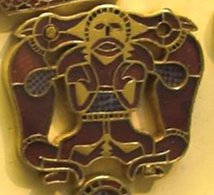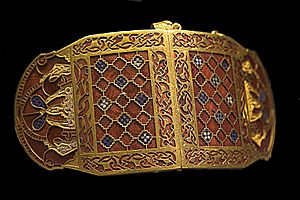Sutton Hoo purse-lid facts for kids
The Sutton Hoo purse-lid is a very special treasure found at the Sutton Hoo burial site in Suffolk, England. This site has many ancient burial mounds. The most important one is Mound 1, which held an untouched ship burial. Inside, archaeologists found many rich grave goods, including this purse-lid.
Most experts believe the person buried in Mound 1 was Rædwald. He was the King of East Anglia and died around 624 AD. The purse-lid is seen as "one of the most remarkable creations of the early medieval period." It is about seven and a half inches long. It is decorated with beautiful gold and garnet jewels using a technique called cloisonné. This means thin metal strips create small sections, which are then filled with gems or enamel. The purse-lid was a clear sign of great wealth and importance. In 2017, you could see it on display at the British Museum.
Who Were the Anglo-Saxons?
Around 410 AD, the Roman soldiers left Britain. Even before this, some Germanic people were already living there. They probably worked as soldiers for the Romans. For the next 150 years, many more people came to Britain. These groups, known as the Anglo-Saxons, created new societies and cultures. They slowly took control of most of Britain. They divided the land into several Anglo-Saxon kingdoms. The Sutton Hoo burial comes from this important time.
What Does the Purse-Lid Look Like?
The purse-lid was the top part of a leather bag used for carrying coins. The leather itself has long since rotted away. But archaeologists found forty Frankish coins and two small metal bars with the lid. Each coin came from a different mint, meaning they were carefully chosen. The purse hung from a belt using the three hinges you can see at the top.
The lid likely had a plate behind the metalwork. This plate was probably made from valuable whalebone "ivory." Today, the lid is shown with a simple replacement plate. The original might have had fancy carvings.
The purse-lid was part of a set of fancy items. These items were worn on the clothing and weapons of the buried person. The set included a gold belt buckle and gold and garnet shoulder-clasps. There were also sword fittings and scabbard mounts. The purse-lid used small and large garnet pieces in a similar way to the shoulder-clasps. This whole set showed how important the East Anglian kings wanted to appear. It mixed ideas from Roman leaders and Germanic warrior culture.
The lid has a kidney shape. It holds a sheet of horn, which is a tough material. On this horn, there are amazing garnet designs. These designs show birds, wolves eating men, and geometric patterns. There's also a double panel with animals whose body parts are intertwined. The artist got these ideas from the helmets and shield decorations also found in the burial. They used great skill to create these designs in the garnet and gold.
On the outside of the lid, there are matching pictures of a man surrounded by two wolves. This is an old design called the Master of Animals. It shows a human controlling wild animals. Between these, there are two more matching figures. These show an eagle swooping down to catch its prey.
For the Anglo-Saxons, these images likely had deep meanings. Today, it's hard for us to know exactly what they symbolized. The men and wolves might refer to the family name of the Sutton Hoo kings, the Wuffingas. This name means "Wolf's People." The images of wolves and eagles could also represent power, bravery, and courage. Above these animal and human figures, the artists added abstract designs.
How Was the Purse-Lid Found?
Sutton Hoo is a group of burial mounds from the 6th and 7th centuries in Suffolk, England. The largest mound, Mound 1, was first dug up in 1939 by Basil Brown. It contained a 90-foot-long (27 m) ship. This is believed to be the burial site of King Rædwald. It was in this mound that archaeologists found the amazing purse-lid.
Sadly, the original notes from the 1939 dig were lost during World War II. Only pictures of the ship's rivets in the sand remain. The items found were sent to London. Work to restore and document them only began after the war ended.
Years later, from 1965 to about 1971, Mound 1 was dug up again. This time, Rupert Bruce-Mitford and then Paul Ashbee led the work. Even later, from 1986 to 1992, the Sutton Hoo Research Committee, led by Martin Carver, re-excavated Mound 2. During this time, archaeologists also dug up Mounds 5, 6, 14, 17, and 18. Carver found thirty-nine more burials. These burials, from the 8th to 11th centuries, might have been "execution burials." This means the bodies found around Mound 5 were likely buried near where a gallows (a structure for hangings) once stood.




